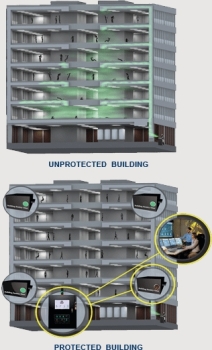Mar 24 2010
Building Protection Systems, Inc., a pioneer in developing of chemical, biological, radiological, nuclear (CBRN) detection system, has achieved a milestone of more than 100,000 operating hours for its Sentry One detection technology without even one false alarm.
 BPSI’s Sentry One - Unprotected and Protected Buildings
BPSI’s Sentry One - Unprotected and Protected Buildings
This is the first time the industry has witnessed such a feat.
Greg Eiler, BPSI’s CEO and Founder, revealed that the industry was cursed with the false alarm issues for decades. Eiler added that infrastructure managers were unwilling to install undependable first generation technologies that would expose millions of persons to harmful effects of a CBRN release. Eiler explained that BPSI’s ability to cross the milestone of 100,000 operating hour is a major step that will motivate more security professionals to utilize the proven solution. Eiler added that this achievement has enhanced the standing of BPSI as the leader in state-of-the-art CBRN technologies.
The extreme vulnerability of public gathering areas, buildings, and mass transit stations to targeted terrorists attacks or accidental airborne CBRN releases has been highlighted by reports generated by the U.S. Department of Homeland Security, National Institute for Occupational Safety and Health (NIOSH), U.S. Army Corps of Engineers, Centers for Disease Control (CDC), Oakridge National Lab, Lawrence Berkeley Lab, and others. The industry has so far not developed any dependable solution for commercial environments, according to these reports.
Tom Ridge, Senior Advisor to BPSI, Ridge Global’s CEO, and the first U.S. Secretary of Homeland Security, informed that countering the challenge of false alarm is difficult. Ridge added that the global security community will have to lower its vulnerability to CBRN attacks. Ridge explained that this need highlights the achievement of BPSI and encourages professionals focusing on alleviating the threat.
Active continuous monitoring systems developed by BPSI are utilized by in facilities and headquarters buildings belonging to Fortune 100 companies. These systems are able to detect and identify toxins within seconds and also activate the predetermined mitigation protocol automatically. At the same time, the BPSI system also conveys location and toxin data in real time to its Remote Monitoring Center that in turn establishes communication with first transponders for carrying out a secure rescue and recovery operation.
Mike Welden, BPSI.’s SVP of Homeland Security, explained that BPSI’s ability to surpass 100,000 operation hours during field operations without even one false alarm has positioned BPSL ahead of the government labs and other competition. Welden revealed that BPSL offers a dependable and established solution for a commercially recognized known vulnerability. Welden added that they have got a right-priced solution designated by the U.S. Department of Homeland Security SAFETY Act and is ready for saving lives.